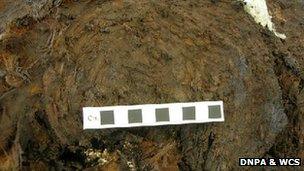Bronze Age burial site excavated on Dartmoor
- Published

The contents of the burial cist have been transported to Wiltshire to undergo micro-excavation
An early Bronze Age burial cist containing cremated bones and material dating back 4,000 years has been excavated on Dartmoor.
Archaeologists uncovered items from the site on Whitehorse Hill including a woven bag or basket and amber beads.
Cists are stone-built chests which are used for the burial of ashes.
Dartmoor National Park Authority (DNPA) said the discovery could be one of the most important archaeological finds in 100 years.
Archaeologists uncovered cremated human bone and a burnt textile woven bag or basket with stitching on it.
The receptacle contained shale disc beads, amber spherical beads and a circular textile band.

Archaeologists want to analyse the woven bag or basket to find out what material was used
All the items were taken to the Wiltshire Conservation Service laboratory for micro-excavation, which DNPA said revealed a "wealth of information that does not normally survive".
The peat and pollen surrounding the cist are due to be analysed and carbon-dated to provide evidence of vegetation and climate at the time of the burial, and the items will be analysed to reveal how they were made and what materials were used.
Jane Marchand, senior archaeologist at DNPA, said: "This is a most unusual and fascinating glimpse into what an early Bronze Age grave goods assemblage on Dartmoor might have looked like when it was buried, including the personal possessions of people living on the moor around 4,000 years ago."
It is the first excavation of a Dartmoor cist for nearly 100 years, although it is known that about 200 exist on the moor.
The cist is to be rebuilt once analysis is concluded.
- Published10 August 2011